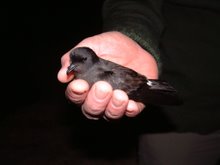This would allow us to test a whole set of new hypotheses about the lives of these highly pelagic birds on the open ocean.
Others have certainly managed it in other parts of the world, including the New Zealanders studying the recently rediscovered New Zealand storm petrel, who have caught several of these remarkable birds at sea, in order to take genetic samples and fit radio-tracking devices in the hope of discovering the birds' breeding colonies.
Most successful have been Gill, Sladen & Huntington, who published a paper in 1970 describing how they caught 117 Wilson's and 13 Leach's petrels (plus 120 assorted shearwaters) using a hoop net hand-thrown from the back of a boat during daylight in the Bay of Fundy, Canada. (Bird-Banding, April 1970, pages 111-113).
This has never yet worked for us off Portugal and after a series of daytime pelagic trips spent half-heartedly waving various prototype nets rather pathetically over the sides of boats, we decided to take another tack.
Preparing yet another unsuccessful version of Gill et al.'s hoop net on a dytime pelagic trip in 2006
.jpg)
A chance encounter with Jose Xavier of Cambridge University at a schoolteacher's climate change seminar in Lagos (organised by A Rocha's own Paula Banza/Felgueiras), led us to Daniel Machado -a marine biology graduate with an 11m catamaran which he has fitted out for a marine ecotourism business venture. Renata, Patricia and Rob went to take a look and realised that it would be perfect for running 9m mist nets along the two hulls! Clearly this needed to be done at night on the open ocean -what could possibly go wrong?

A trial run fitting the mist nets during daylight -note the confident grins!

And so it came to pass that one not too stormy night, Rob, Mark, Colin & Jez, captained by Daniel and crewed by Andre, set sail from Portimao out onto the trackless ocean. Once we had reached about 10km offshore, Daniel and Andre furled the sails and we set two mist nets along each hull of the catamaran. We were very pleased with the result -two absolutely taut and rigid mist nets, floating on an artificial "island"!
Oh captain, our captain! Daniel at the wheel, sailing out from Portimao at dusk

Colin was "volunteered" to tie off the mist net at the far end of the hull.
There then followed a slightly disappointing couple of hours of swaying around, with no birds attracted to the tapes. In desperation, we shone some torches over the sea, to see if we could spot any passing stormies. To our surprise, the sea was alive with petrels, some of which seemed to change direction in response to the torch beams and could be "steered" towards the nets! Suddenly there was a storm petrel flying in an arc over Colin's torch, over our heads... and... it tumbled into the mist net right next to Rob! Rob held onto the bird, Jez grabbed Rob and Mark grabbed Jez. The surprised bird was safely weighed, measured and released, amid scenes of great rejoicing!
Ringing inside the cabin

Some time later, another bird was landed on the deck next to Mark, who calmly picked it up and appeared from behind the cabin exclaiming "I've got one in my hand!" More measurements ensued, and we continued trying to catch more birds until our torch batteries gave out and the strengthening wind forced us to move closer inshore.
And so we arrived back at Portimao at dawn, after an exhilarating night of scientific adventures, and looking forward to having another go next year! (I speak for myself, clearly -Rob). Thanks to Daniel and Andre for looking after us -if you'd like to contact Daniel about boat hire etc, click here.







No comments:
Post a Comment